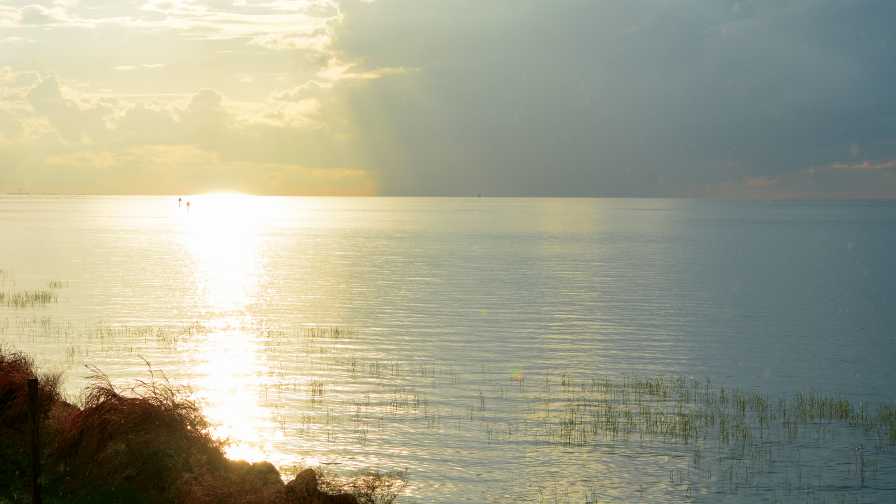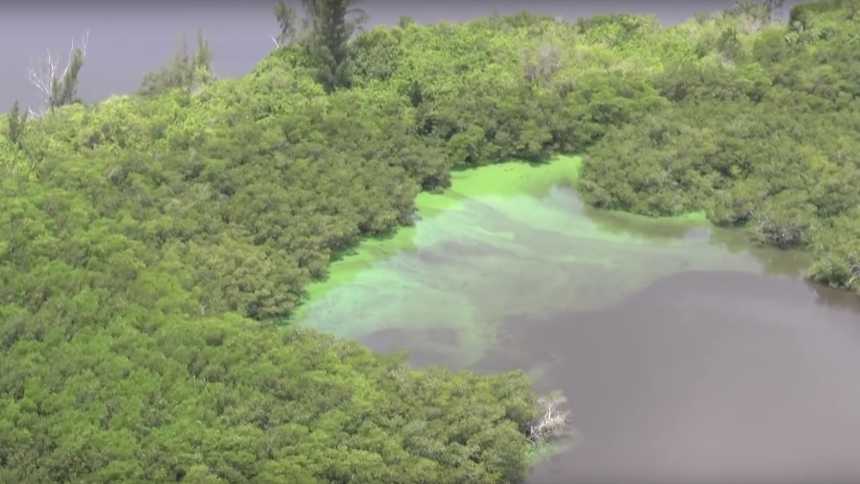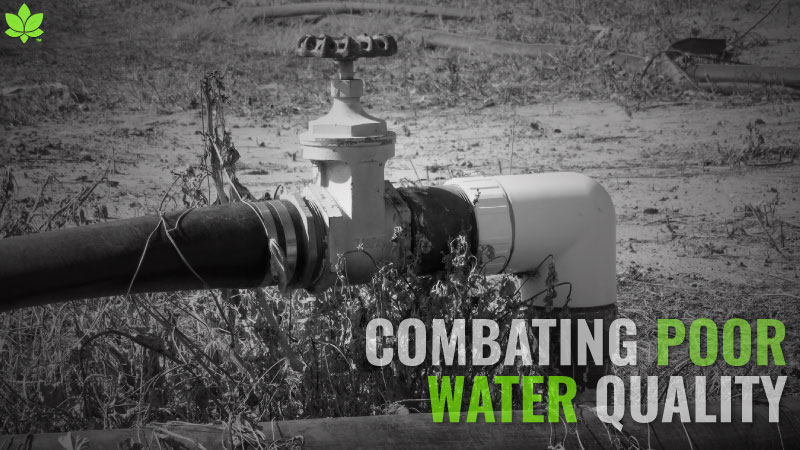Florida Farmers Look for High Ground in Raging Water Debate

Lake Okeechobee has been the focal point of recent debate over water quality, but Florida policymakers are developing new guidance that would apply to all stakeholders statewide. Photo by Frank Giles
Algae blooms and red tides have visited Florida for generations. But in 2018, when a red tide overlapped with a blue-green algae outbreak in a horrific manner, it placed a renewed emphasis on gaining a better understanding how they are triggered and ways to mitigate and reduce their occurrence.
What is known is that nutrient-rich water can enhance and prolong both freshwater algal blooms and red tides originating from the Gulf that get pinned along the shoreline by currents. In 2018, as both phenomena persisted for months, finger pointing ensued on who was to blame for seeding lakes, estuaries, and coastlines with the nutrients that were enhancing the problem. Agriculture was often at the center of the blame game as media and politicians fed off the headline-creating debate.
Calmer Conversations
While the debate remains hot, calmer conversations have been taking place since the troubles of 2018. That is partly being driven by the Blue-Green Algae Task Force appointed by Gov. Ron DeSantis in February 2019. Its work and other topics were covered during a recent panel discussion during the Florida Fruit & Vegetable Association Annual Conference in Palm Beach. Participating on the panel were Ernie Barnett, Executive Director of the Florida Land Council; Dr. Wendy Graham, Director of the University of Florida’s Water Institute and member of the Blue-Green Algae Task Force; and Noah Valenstein, Secretary of the Florida Department of Environmental Protection (DEP).
The panel noted that last year’s water woes pointed out the need for more information and transparency on actions being taken to protect the state’s water quality. That has been part of the task force’s mission to find out where the gaps in information and data exist and provide recommendations on how to fill those gaps.
“We have seen a lot of effort in the past year to create public gatherings where the state can come in and present the best information we have and what we are doing about it,” Valenstein noted.
Barnett noted that it became nearly impossible for the public to differentiate between the two events occurring along the coasts in 2018. “These red tides proliferate in the Gulf, and since 1950, we have had 59 red tides,” he said. “Typically, when you look at mortality of dolphins and sea life, it is driven more by red tide. But, since both were happening at the same time, blame started to be shifted toward land-based activities [which feed blue-green algae]. That is where agriculture came into the discussion.”
In 2018, a large algal bloom formed on Lake Okeechobee, which was sent to the coast in lake discharges via the Caloosahatchee River. Barnett said it is no surprise that nutrients in the Okeechobee basin are largely from agriculture because it is the dominant activity in that region.
“The Okeechobee basin is predominantly agriculture with the exception of the headwaters, which is being impacted by what is happening [urban-based] in Orlando and Osceola County,” Barnett said. “The same goes for the Suwannee basin. But if you look at the Rainbow River, it is going to be influenced mostly by urban activity. Land-use activities are going to drive the types of nutrient loads and how water bodies will be impaired.”
He added that agriculture has worked to better manage nutrient inputs and water movement off the farm through various BMP programs. And that all land activities – not just agriculture — feed into the blue-green algae outbreaks, including septic, urban stormwater runoff, wastewater treatment, and more.

FFVA’s 2019 Annual Conference featured a high-level panel discussion on water quality and policy. From left: Wendy Graham, Director of the University of Florida’s Water Institute, Noah Valenstein, Secretary of the Florida Department of Environmental Protection, and Ernie Barnett, Executive Director of the Florida Land Council.
Photo by Frank Giles
More Data Needed
What has become clear is that more information and science are needed to determine the impacts of current practices and to better predict future blooms and tides and their duration.
“For all the BMPs and how we are living in our urban, suburban, and agricultural lands, we need to be able to quantify how well practices are working so we can design regional water treatments systems to pick up where [best practices] leave off,” Graham said. “For stormwater treatment and agricultural BMPs, we have heard some real questions about their efficacy, so there is probably new science needed to better quantify how effective these practices can be on the landscape scale. We must recognize that we all live, eat, and work here, so what can’t be managed at the BMP level will require regional [water] treatment. We have known for a long time that we need large water storage to prevent these nutrients from loading natural systems.”
Valenstein added before the state begins looking at new policies, it’s important to get a better handle on how current regulations are being implemented and investigate whether the supposed benefits from those regulations are being achieved.
“We must clearly identify the benefits of the BMPs and research them in all geographic regions of the state to see what results we are getting out of what is already on the books,” he said. “The same goes for stormwater.”
Task Force Recommendations
In late September, the Blue-Green Algae Task Force released the draft of its consensus document, which lays out priority areas related to water quality and suggests actions that can be taken to address each sector. The document focused on Basin Management Action Plans (BMAPS), agricultural BMPs, septic tanks, sanitary sewer overflows, and stormwater treatment.
In BMAP regions, agricultural BMPs are statutorily required to be adopted and implemented and are presumed to be reducing environmental impacts in those areas. According to the draft, only 75% of eligible agricultural parties within the Lake Okeechobee BMAP area are enrolled in an appropriate BMP. Enrollment numbers are considerably less in other BMAP areas.
The task force recommends that action be taken to encourage increased BMP enrollment in all regions of the state. The group also recommends that growers enrolled in BMP programs maintain accurate records to demonstrate they are implementing BMPs and that those records are verified by the appropriate regulatory authority and available to the public.
There are limited data available outside of the Everglades Agricultural Area (EAA) that demonstrate BMPs’ environmental benefits. The task force recommends that sampling be conducted to verify that BMPs are having the desired impact in reducing nutrient loads in waterways.
The draft document suggests: “Reporting of input reductions for all operations receiving a presumption of compliance and the implementation of sampling programs to assess the effectiveness of sector-specific BMPs intended to reduce nutrient loading to adjacent water bodies should be initiated.”
The group also recommends that BMP manuals should undergo regular review to reflect new knowledge about nutrient impacts on crop yields and water quality. The manuals also should reflect technological advancements that can help reduce nutrient leaching and runoff.
There are many details that must be sorted out after the task force’s guidance receives public comment and is presented to the legislature for all the lawmaking and funding that must follow. During the panel discussion, Barnett cautioned that changes to the agricultural BMP program must be technically and economically feasible.
“The worst thing we could do is put a very vigorous command and control program on top of agriculture that in many cases is dealing with a thin profit margin and start putting growers out of business,” Barnett said. “We would then end up with a worse economic and environmental situation than we already have.”
Graham echoed those thoughts pointing out the ecosystem services agriculture provides. “We need for the state to consider some form of payment for environmental services to encourage that these lands stay agricultural and underdeveloped,” she noted. “These lands have wildlife values and water storage potential. It makes me very nervous considering solid urban development from Daytona Beach to Tampa and all those water recharge areas that could be paved over. Right now, BMPs are practical and economically feasible to reduce nutrients, but there might be some things growers could do that are valuable to [protecting water resources] and not harm their bottom line. As a society, it may be cheaper helping growers to keep nutrients out of the system versus having to pay to take them out of water systems later.”
The panelist agreed that the water quality challenge can only be addressed by following science and all stakeholders working together toward solutions.
“The main point is not one single sector is responsible for these [bloom and tide events], and not one single sector is going to be able to solve these problems,” Barnett noted.
Click here a draft of the Blue-Green Algae Task Force.
Editor’s Note: Given the complicated nature of this subject, not all areas of concern could be addressed in this story. Stayed tuned for continuing coverage on water in the coming year.

Whether standing on the ground or from a bird’s eye view, algal blooms are easy to spot.
Image courtesy of Martin County, FL (martin.fl.us)
Strength in Numbers
As the water debate heats up, a coalition of more than 20 leading agricultural groups, business, and institutions have come together to represent and speak with one voice on behalf of agriculture. Their mission is to seek comprehensive solutions to harmful algal blooms in Florida that involve all stakeholders — residents, business, municipalities, utilities, agriculture, and others.
Some of the group’s legislative priorities include:
- Adequate funding for Florida Department of Agriculture and Consumer Services Office of Agricultural Water Policy
- Funding for various water storage and treatment projects on public and private lands
- Funding for new research on finding implementable solutions to mitigate red tide and blue-green algae
- Support cost-share funding for sewer and septic conversions
- Requirement for proper septic system maintenance
- Support funding to expedite repairs to the Herbert Hoover dike on Lake Okeechobee










